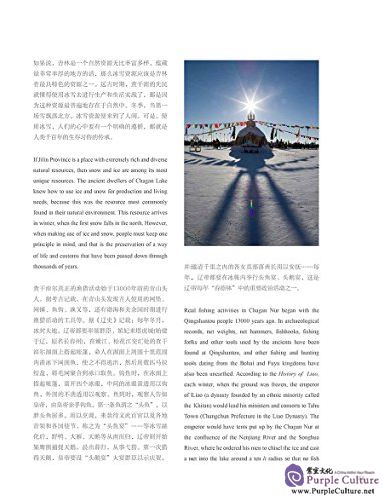Sample Pages Preview
把头还要会看“鱼花”。鱼花,又叫鱼泡泡,是鱼 喘息时吐出的气。在冬天,鱼喘出的气会在冰中形 成一层一层的泡,这叫鱼花,说明这儿冰底下有 鱼。 而鱼花又分“ 新花” 和“ 旧花”, 又叫“老 花”。新花,是鱼刚吐的,或昨晚上吐的,特征 是这些“花”在冰水里还在晃动、晃荡,说明有鱼 群,把头正好可以指挥人在此凿冰下网。而旧花, 是指那些已冻结在冰层里的泡泡。这些“花”一动 也不动,说明鱼群已经过去了。不懂鱼性的人才会 在旧花处凿冰开眼。
The fishing master must also be able to read “fish flower”, also known as fish bubble, which is gas exhaled by fish that escapes as bubbles. In winter, the gas forms layers and layers of bubbles in the ice, i.e., fish flower, indicating the presence of fish underneath. Fish flowers are divided into “new flowers” and “old flowers”. The new flowers are fresh bubbles just made by the fish or the night before, and are still quivering and floating in the icy water, which indicates that the fish are still there. This is where the fishing master will have his team chisel the ice and cast the net. The old flowers are bubbles that are already frozen in the ice. These “flowers” do not move, indicating that the fish have already left. Only people who don’t understand fish behavior will make ice holes where the “old flowers” are.
“花”还分多种,有一种花称为“草花”,把头会 一眼认出。草花,是水里的草吐出的气泡。冬天草 一冻也会吐气泡,称为草花。草花的特征是一冒到 顶,形状是一串一串的,被渔民称为“串泡”。鱼 花则是一层一层,一片一片的,有明显的区别。这 些本事都是老渔把头的看家本领。
The “flower” can be further divided into different categories. There is the “grass flower”, which the fishing master can recognize instantly. They are bubbles made by water grass, and their most distinctive feature is that the bubbles rise to the top in strings, and are called “string bubbles” by the fishermen. The fish flowers are recognizably different from grass flowers in that they form in layers and patches. Knowing all this is what makes the fishing master a fishing master.
在查干淖尔,冬季捕鱼网上冰前,要先选出领网的, 领网的人往往被冬捕的人称为二把头。顾名思义,领网,就是指带领这伙人实际在冰上作业。当把头 观察完下网点,他还有诸多的事情要做,什么卖鱼 呀,接待来客呀,都由把头去做,于是冰上的活就 交给领网把头领着去干。领网把头要懂得捕鱼各个 环节中的规俗和技术,比如需要“穿草鞋”或“摘 挂子”时,领网的要及时发现,并组织和指派“跟 网的”去处理。领网人,心眼要正,一碗水要端 平;该谁的活,就由谁去干,不能看人下菜碟。不 然时间长了,他在冰面上没有威信,跟网的就会和 他有二心。
Before winter fishing begins in Chagan Nur, the fishermen also have to elect the net leader, who is known as the number two man after the fishing master. As the name suggests, the net leader refers to the person who leads the fishing crew in actual operations on the ice. After deciding on the net casting spots, the fishing master has many other tasks to attend to, such as selling the fish, receiving guests, etc., so command is handed over to the net leader. The net leader must have mastered the customs and techniques relating to various aspects of winter fishing. For instance, if the need arises to “put on grass shoes” or “disentangle the net”, the net leader must promptly identify the problem and assign the “net handlers” to deal with it. The net leader must be impartial in allocating work, assigning tasks to whoever should be responsible, showing no favoritism. Otherwise, over time he will lose his authority on the ice and the loyalty of the net handlers.
冬捕中“穿草鞋”,其实不是真草鞋,而是用谷草 或稻草拧成的草把。冬季冰下捕鱼,是技术性很强 的一种渔猎活动,要把偌大的网在冰层下展开,而 送网要从事先凿开的冰眼(冰洞)下网,由于冰下 的泥地都不是一码平地,有时就是草根、树茬、稀 泥、高岗或大坑,不利于网的送运,就得“穿草 鞋”。穿草鞋又叫“拴草鞋”,是指在网进入到这 样的地段时,在网边底绑上一个个草把,使网在冰 层底下的塘泥上便于滑动。于是这穿草鞋就成了捕鱼过程中的一道绝活。
In winter fishing, “putting on grass shoes” is not used in the literal sense. The grass shoe in fact refers to a bundle of straw. Winter ice fishing is highly technical, where a large net is spread under ice through ice holes chiseled in advance, and the terrain beneath the ice is not always flat and smooth. In some places the surface is covered with grassroots, tree stubbles, mud, hillocks or big pits that hinder the net’s movement. Such occasions call for “putting on grass shoes”. Also called “tying on grass shoes”, it means tying straw bundles under the net when it enters rough terrain to make it easier for the net to slide along the mud beneath the ice. This is another highly technical task in the process of winter fishing.
在网由冰眼下到冰底时,把头在冰面上来回走动, 观察网运送的速度,一旦发现网走得慢了,就知有 不顺畅的地方了,于是就大喊:“穿草鞋!”
把头的话,就等于命令一样。这时,专门有一个叫 “打串连”的人,答应一声,立刻抄起“串连杆子”
(一种六米至九米长的杆子,头上有一个尖,顶上带 个钩)把一捆谷草勾在上面,然后从出问题最近的网 眼下杆子,将杆子和谷草捆对准那儿的网扣,手腕一 打,杆子带着谷草捆顺直往前运行,并准确地垫在网 下的不平处。这就叫“穿草鞋”或“拴草鞋”。查干 淖尔冬捕渔队中有诸多的打串连“穿草鞋”的能手。 这些人一要迅速理解渔把头的意图;二要及时判断网 在冰层下的复杂情况;三要会用腕劲。
When the net is cast from the ice eye to spread under the ice, the fishing master walks back and forth on the ice to observe the progress. If there is a delay, he knows that the net has run into a rough spot, at which point he will call out: “Put on the grass shoes!”



